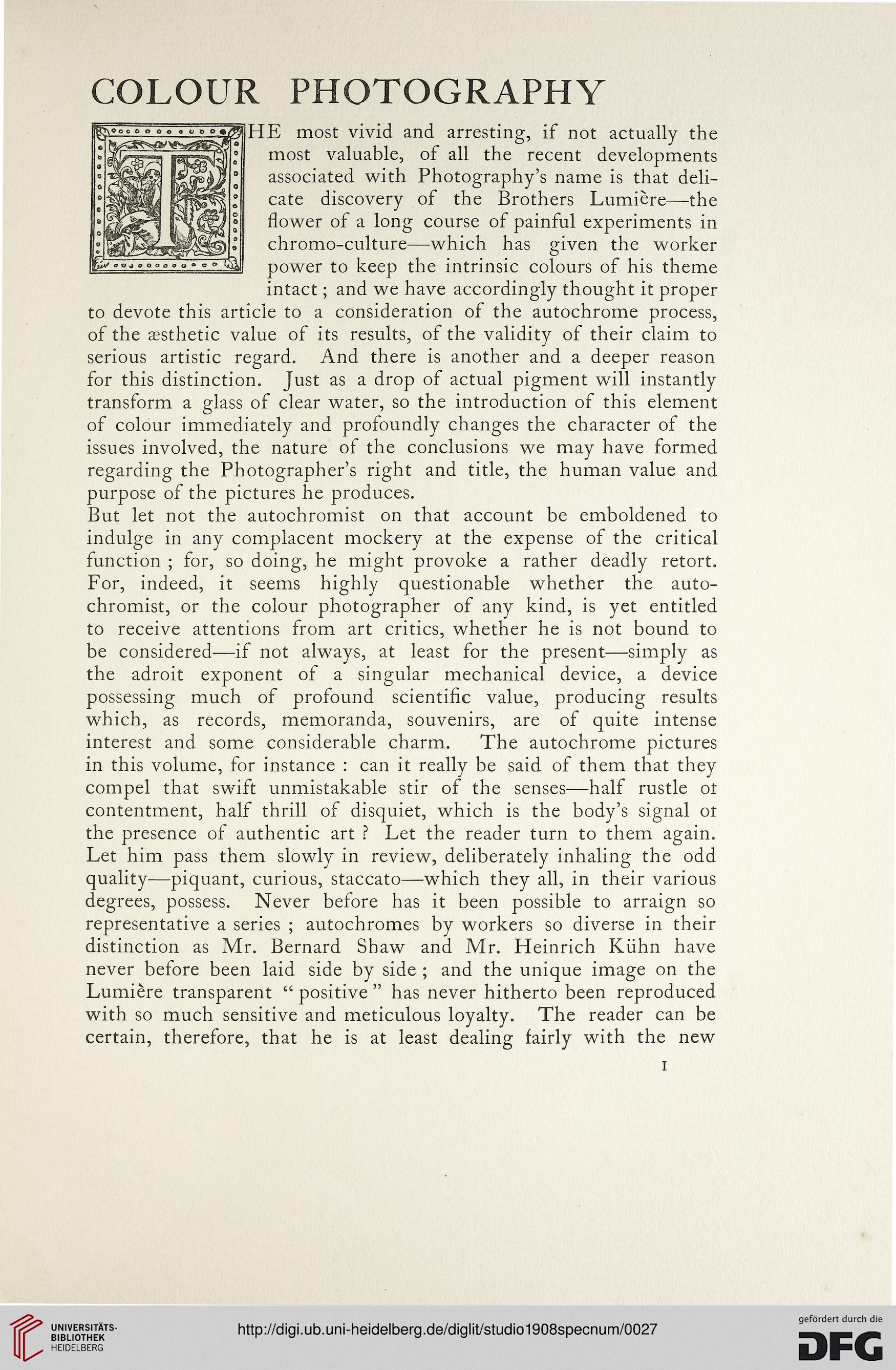COLOUR PHOTOGRAPHY
HE most vivid and arresting, if not actually the
most valuable, of all the recent developments
associated with Photography’s name is that deli-
cate discovery of the Brothers Lumiere—the
flower of a long course of painful experiments in
chromo-culture—which has given the worker
power to keep the intrinsic colours of his theme
intact; and we have accordingly thought it proper
to devote this article to a consideration of the autochrome process,
of the aesthetic value of its results, of the validity of their claim to
serious artistic regard. And there is another and a deeper reason
for this distinction. Just as a drop of actual pigment will instantly
transform a glass of clear water, so the introduction of this element
of colour immediately and profoundly changes the character of the
issues involved, the nature of the conclusions we may have formed
regarding the Photographer’s right and title, the human value and
purpose of the pictures he produces.
But let not the autochromist on that account be emboldened to
indulge in any complacent mockery at the expense of the critical
function ; for, so doing, he might provoke a rather deadly retort.
For, indeed, it seems highly questionable whether the auto-
chromist, or the colour photographer of any kind, is yet entitled
to receive attentions from art critics, whether he is not bound to
be considered—if not always, at least for the present—simply as
the adroit exponent of a singular mechanical device, a device
possessing much of profound scientific value, producing results
which, as records, memoranda, souvenirs, are of quite intense
interest and some considerable charm. The autochrome pictures
in this volume, for instance : can it really be said of them that they
compel that swift unmistakable stir of the senses—half rustle oi
contentment, half thrill of disquiet, which is the body’s signal or
the presence of authentic art ? Let the reader turn to them again.
Let him pass them slowly in review, deliberately inhaling the odd
quality—piquant, curious, staccato—which they all, in their various
degrees, possess. Never before has it been possible to arraign so
representative a series ; autochromes by workers so diverse in their
distinction as Mr. Bernard Shaw and Mr. Heinrich Kuhn have
never before been laid side by side ; and the unique image on the
Lumiere transparent “ positive ” has never hitherto been reproduced
with so much sensitive and meticulous loyalty. The reader can be
certain, therefore, that he is at least dealing fairly with the new
i
HE most vivid and arresting, if not actually the
most valuable, of all the recent developments
associated with Photography’s name is that deli-
cate discovery of the Brothers Lumiere—the
flower of a long course of painful experiments in
chromo-culture—which has given the worker
power to keep the intrinsic colours of his theme
intact; and we have accordingly thought it proper
to devote this article to a consideration of the autochrome process,
of the aesthetic value of its results, of the validity of their claim to
serious artistic regard. And there is another and a deeper reason
for this distinction. Just as a drop of actual pigment will instantly
transform a glass of clear water, so the introduction of this element
of colour immediately and profoundly changes the character of the
issues involved, the nature of the conclusions we may have formed
regarding the Photographer’s right and title, the human value and
purpose of the pictures he produces.
But let not the autochromist on that account be emboldened to
indulge in any complacent mockery at the expense of the critical
function ; for, so doing, he might provoke a rather deadly retort.
For, indeed, it seems highly questionable whether the auto-
chromist, or the colour photographer of any kind, is yet entitled
to receive attentions from art critics, whether he is not bound to
be considered—if not always, at least for the present—simply as
the adroit exponent of a singular mechanical device, a device
possessing much of profound scientific value, producing results
which, as records, memoranda, souvenirs, are of quite intense
interest and some considerable charm. The autochrome pictures
in this volume, for instance : can it really be said of them that they
compel that swift unmistakable stir of the senses—half rustle oi
contentment, half thrill of disquiet, which is the body’s signal or
the presence of authentic art ? Let the reader turn to them again.
Let him pass them slowly in review, deliberately inhaling the odd
quality—piquant, curious, staccato—which they all, in their various
degrees, possess. Never before has it been possible to arraign so
representative a series ; autochromes by workers so diverse in their
distinction as Mr. Bernard Shaw and Mr. Heinrich Kuhn have
never before been laid side by side ; and the unique image on the
Lumiere transparent “ positive ” has never hitherto been reproduced
with so much sensitive and meticulous loyalty. The reader can be
certain, therefore, that he is at least dealing fairly with the new
i




